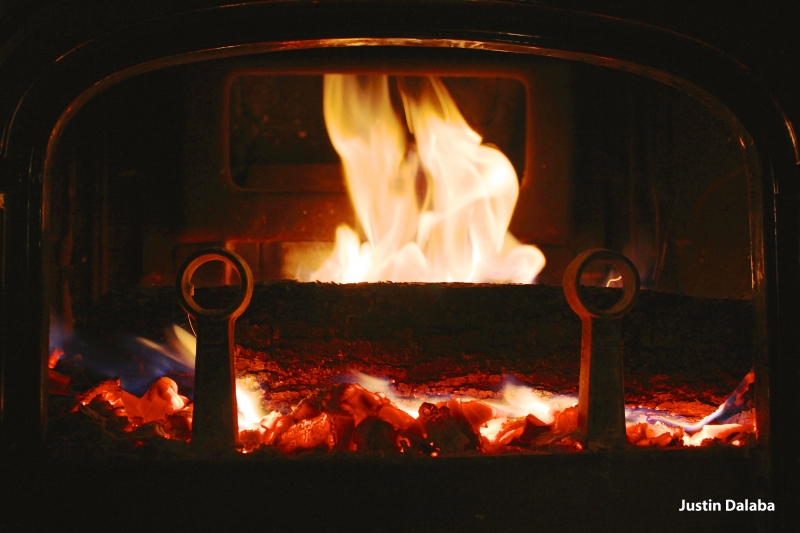
Carry Wood, Boil Water
How much are you willing to pay to boil water? I don’t mean to make coffee or cook pasta, but for the heck of it. Would you spend $200 to $600 annually just to let off some steam?
Probably not, right? But if you heat with wood, you already shell out hard-earned money each year to boil water for no practical reason. Every drop of moisture in your firewood costs you money as well as effort, and it makes it harder to keep the house warm. And because damp wood burns cooler, the flue accumulates creosote quickly. The risk of a chimney fire increases with wood moisture content, and summer is the time of year to wring the water out of your wood.
I’m guilty of wasteful water-boiling, too. Let’s face it, we all have so many pressing things that need to get done in a given 24-hour period that it’s easy to put off stacking and covering firewood early in the season one more day. And then another day, and another and...you know.

So how much are we spending to use our wood stoves or wood furnaces as drying kilns? For the sake of argument let’s say it takes twelve face cords of apple wood to heat a northern NY house for the winter. While it’s unlikely one would get a load of apple, I chose it because it’s one of the best firewood species in terms of heat value per volume. (Last spring in Wolcott, NY I saw mountains of big old apple trees bulldozed up to make room for new varieties, so it could happen.)
Not all firewood is created equal. In northern NY, hard or sugar maple is considered by many to be the gold standard of firewood. When dry, it contains about 24 million British thermal units (mBTUs) per full cord. (A full cord contains three standard 16” long face cords, and a BTU is the energy it takes to heat one pound of water one degree Fahrenheit.)
At 26.5 mBTUs per dry cord, apple has hard maple beat hands-down. By contrast, dry basswood has 13.5 mBTUs per cord and poplar has about 14. Black locust, recently classified as an invasive species in NY State, is also great fuel wood, rated at 27 mBTUs. The best North American hardwood I know of is Osage orange, native to the Midwest. It comes in at 33 mBTUs/cord.
We’ll assume you’re thrilled with your load of apple, which would cost the same as white ash but is about 15% more valuable. Cut, split and delivered, this might run $65.00 per face cord for an annual heating bill of $780.00, which incidentally is pretty cheap.
Here’s the rub: compared to its dry weight, apple is about 77% water. If you don’t get your precious wood dry before winter, it will only give you 18.5 mBTUs, It will be harder to maintain a hot fire in the stove, and you’ll be less comfortable in the house. You’ll have to clean the chimney more often and whoever lives downwind from you will eat a lot more smoke. And the bottom line is that because 8 million BTUs were used to boil water, you’ll have suffered a 27 % financial loss—it will have cost you about $210.00 to boil water.
And here’s the deep-muscle rub: if you’re handling unseasoned wood, by springtime you will have lifted and lugged 4,592 pounds of water for nothing. How’s your back, by the way?
An increased chance of a chimney fire may seem hypothetical. It won’t happen to me, right? I’ll clean the flue in time. More pollutants going into the air may be a matter of opinion, or at least of perspective. Wood smoke smells good—what’s the problem? But less money in your wallet is pretty understandable no matter how you slice it.

The keys to drying firewood are to cut and split it early, preferably 12 months in advance of burning, and stack it such that it has good air circulation. Oh, and protecting it from the weather is a capital idea. Cover woodpiles on the top only, as side coverings will hamper drying.
Oddly enough, green wood that is periodically wetted down dries faster than wood that is placed under cover, because the outermost fibers remain opened, allowing moisture to escape from deeper in the wood. That’s no excuse for leaving wood piles uncovered, though.
To burn even marginally clean, firewood has to be below 25% moisture. Wood is hygroscopic, that is it absorbs moisture from the air depending on the humidity. However, even in extreme humid conditions, wood that is covered for six months or more will not be over 20% moisture.
Let’s use fuel wood for heating the house, not for randomly boiling water. If you want to put the kettle on the woodstove for tea, that’s perfectly acceptable.

